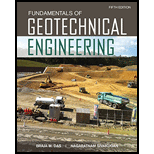
Fundamentals of Geotechnical Engineering (MindTap Course List)
5th Edition
ISBN: 9781305635180
Author: Braja M. Das, Nagaratnam Sivakugan
Publisher: Cengage Learning
expand_more
expand_more
format_list_bulleted
Concept explainers
Question
Chapter 5, Problem 5.15P
(a)
To determine
Plot the compaction test data and determine the optimum moisture content and the maximum dry unit weight.
(b)
To determine
Plot the zero air void curve and check whether it intersects the compaction curve.
(c)
To determine
Plot the void ratio and degree of saturation against the moisture content.
(d)
To determine
Find the optimum moisture content, void ratio, and degree of saturation.
Expert Solution & Answer
Trending nowThis is a popular solution!

Students have asked these similar questions
A sample coarse grained soil is 50mm. In diameter and 150mm long was tested in a constant-head apparatus. The soil sample was prepared at a void ratio of 1.5. The total head was kept constant at 300mm and the amount of water is collected in 4 sec. was 50cm^3. The test temperature was 22°Ca.) Compute the temperature correction factor.b.) Compute the corrected coefficient of permeability in cm/sec.
c.) Compute the interstitial velocity.
During a falling head test, the head fell from 80cm to 65cm in 83 seconds. The specimen was 5cm in diameter and had a length of 100mm. the diameter of the standpipe was 0.80 cm. Temperature during the test is 90deg. C.
a.) Compute the coefficient of permeability of the soil at 20deg. C _____cm/min
b.) Compute Seepage velocity if the void ratio is 0.90 _____cm/min
c.) Determine the Rate of flow _____cm/min
The laboratory compaction test of a certain type of soil gives a maximum dry density of 1486 g/m3 with an optimum moisture content of 12.5%. The following are the results of a field unit weight determination test using sand cone method. Volume of soil excavated from the hole = 0.001337 m3 Weight of soil from the hole when wet = 2220 g Weight of soil from the hole when dried = 1890 g Determine the field unit weight of soil in g/cm3. Determine the relative compaction, then tell whether it is within the allowable range for relative compaction of 95 ± 0.20?
Chapter 5 Solutions
Fundamentals of Geotechnical Engineering (MindTap Course List)
Knowledge Booster
Learn more about
Need a deep-dive on the concept behind this application? Look no further. Learn more about this topic, civil-engineering and related others by exploring similar questions and additional content below.Similar questions
- 9. The results of a Standard Proctoretest is tabulated as follows: (CHECK PICTURE) Determine the maximum dry unit weight of compaction Determine the void ratio at the optimum moisture content Gs = 2.68 Determine the optimum moisture content Determine the degree of saturation at the optimum moisture contentarrow_forwardProblem # 1. A constant head permeability test is performed on a sample of granular soil. The length of the soil sample is 15 cm and the cross-sectional area is 10 cm^2. If a 24 cm^3 volume of water passes through the oil sample in a 3-minute period and the constant head is 30 cm determine the followinga. Determine the coefficient of permeability of the soil.b. Find the discharge velocity.c. Compute the seepage velocity if the void ratio is 0.64.arrow_forwardA 1 m thick soil with an initial void ratio of 0.94 was compacted by a roller and its thickness reduced by 0.09 m. The specific gravity of this soil is 2.65. A 178.0 g soil sample was collected from the compacted soil mass to examine the degree of compaction. The sample was dried in an oven for 24 hours and it had a dry mass of 142.4 g. Determine the degree of saturation of the soil after the compaction.arrow_forward
- Sand is used in the cone is known to have a bulk density of 15.74 kN/m3 Wet weight=20.601 N Dry weight =17.926 N Weight of sand to fill test hole =16.053 N a) Determine the in-place dry density of the tested soil (Ans. 17.57 kN/m3) b) Determine the water content (Ans. 15%) c) Compute the percentage of compaction of the tested soil if the laboratory moisture density curve indicates a dry density of 18.1 kN/m3 and an optimum moisture content of 13%. (Ans. 97.07%)arrow_forwardA field sand cone test is performed on a layer of compacted fill. determined that the fill soil has a maximum dry unit weight of approximately 120 pcf. Determine the relative compaction of the compacted fill. Unit weight of dry uniform of sand: 95 pcf Weight of sand to fill the cone: 1.10 lb weight of jar + cone + sand (before test): 16.5 lb Weight of jar + cone + sand (after test): 10.5 lb Weight of moist soil excavated from hole: 6.60 lb Moisture content of soil from hole: 10 %arrow_forwarda. What is the compacted dry density?b. What is the field water content?c. What is the relative compaction?d. Does the test meet specifications?e. What is the degree of saturation of the field sample?f. Plot the laboratory curve and the results of the sand cone test on the same graph. Show the limits of the acceptable range.arrow_forward
arrow_back_ios
arrow_forward_ios
Recommended textbooks for you
 Fundamentals of Geotechnical Engineering (MindTap...Civil EngineeringISBN:9781305635180Author:Braja M. Das, Nagaratnam SivakuganPublisher:Cengage Learning
Fundamentals of Geotechnical Engineering (MindTap...Civil EngineeringISBN:9781305635180Author:Braja M. Das, Nagaratnam SivakuganPublisher:Cengage Learning Principles of Foundation Engineering (MindTap Cou...Civil EngineeringISBN:9781337705028Author:Braja M. Das, Nagaratnam SivakuganPublisher:Cengage Learning
Principles of Foundation Engineering (MindTap Cou...Civil EngineeringISBN:9781337705028Author:Braja M. Das, Nagaratnam SivakuganPublisher:Cengage Learning Principles of Geotechnical Engineering (MindTap C...Civil EngineeringISBN:9781305970939Author:Braja M. Das, Khaled SobhanPublisher:Cengage Learning
Principles of Geotechnical Engineering (MindTap C...Civil EngineeringISBN:9781305970939Author:Braja M. Das, Khaled SobhanPublisher:Cengage Learning

Fundamentals of Geotechnical Engineering (MindTap...
Civil Engineering
ISBN:9781305635180
Author:Braja M. Das, Nagaratnam Sivakugan
Publisher:Cengage Learning

Principles of Foundation Engineering (MindTap Cou...
Civil Engineering
ISBN:9781337705028
Author:Braja M. Das, Nagaratnam Sivakugan
Publisher:Cengage Learning

Principles of Geotechnical Engineering (MindTap C...
Civil Engineering
ISBN:9781305970939
Author:Braja M. Das, Khaled Sobhan
Publisher:Cengage Learning